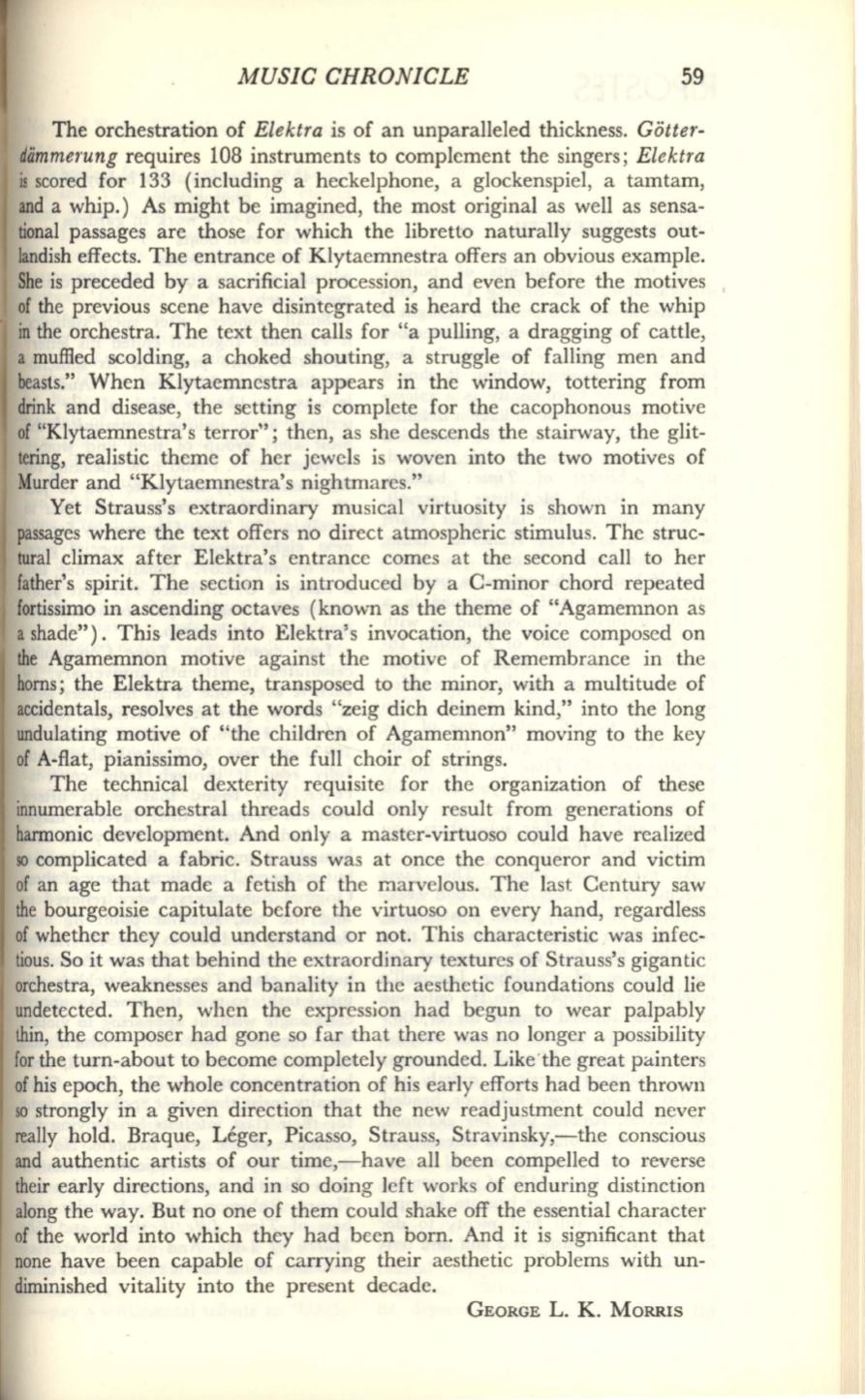
MUSIC CHRONICLE
59
The orchestration of
Elektra
is of an unparalleled thickness.
Gotter–
dammerung
requires 108 instruments to complement the singers;
Elektra
is
scored for 133 (including a heckelphone, a glockenspiel, a tamtam,
and a whip.) As might be imagined, the most original as well as sensa–
tional passages are those for which the libretto naturally suggests out–
landish effects. The entrance of Klytaemnestra offers an obvious example.
She is preceded by a sacrificial procession, and even before the motives
of the previous scene have disintegrated is heard the crack of the whip
in
the orchestra. The text then calls for "a pulling, a dragging of cattle,
a muffled scolding, a choked shouting, a struggle of falling men and
beasts." When Klytaemncstra appears in the window, tottering from
drink and disease, the setting is complete for the cacophonous motive
of "Klytaemnestra's terror"; then, as she descends the stairway, the glit–
tering, realistic theme of her jewels is woven into the two motives of
Murder and "Klytaemnestra's nightmares."
Yet Strauss's extraordinary musical virtuosity is shown in many
passages where the text offers no direct atmospheric stimulus. The struc–
tural climax after Elektra's entrance comes at the second call to her
father's spirit. The section is introduced by a C-minor chord repeated
fortissimo in ascending octaves (known as the theme of "Agamemnon as
a shade"). This leads into Elektra's invocation, the voice composed on
the Agamemnon motive against the motive of Remembrance in the
horns; the Elektra theme, transposed to the minor, with a multitude of
accidentals, resolves at the words "zeig dich deinem kind," into the long
undulating motive of "the children of Agamemnon" moving to the key
of A-flat, pianissimo, over the full choir of strings.
The technical dexterity requisite for the organization of these
innumerable orchestral threads could only result from generations of
harmonic development. And only a master-virtuoso could have realized
50
complicated a fabric. Strauss was at once the conqueror and victim
of an age that made a fetish of the marvelous. The last Century saw
the bourgeoisie capitulate before the virtuoso on every hand, regardless
of whether they could understand or not. This characteristic was infec–
tious. So it was that behind the extraordinary textures of Strauss's gigantic
orchestra, weaknesses and banality in the aesthetic foundations could lie
undetected. Then, when the expression had begun to wear palpably
thin, the composer had gone so far that there was no longer a possibility
for the turn-about to become completely grounded. Like 'the great painters
of his epoch, the whole concentration of his early efforts had been thrown
50
strongly in a given direction that the new readjustment could never
really hold. Braque, Leger, Picasso, Strauss, Stravinsky,-the conscious
and authentic artists of our time,-have all been compelled to reverse
their early directions, and in so doing left works of enduring distinction
along the way. But no one of them could shake off the essential character
of the world into which they had been born. And it is significant that
none have been capable of carrying their aesthetic problems with un–
diminished vitality into the present decade.
GEoRGE
L. K. MoRRis


